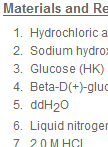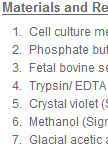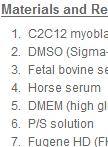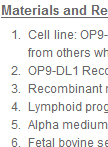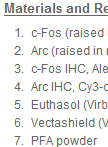Improve Research Reproducibility A Bio-protocol resource
- Protocols
- Articles and Issues
- About
- Become a Reviewer
Past Issue in 2012
Volume: 2, Issue: 10
Biochemistry
Analysis of Mouse Liver Glycogen Content
Liver is the major site for glycogen storage. Glycogen content can be significantly altered upon disruption of glucose homeostasis in metabolic syndromes, such as diabetes. Glycogen content can be determined by an acid-hydrolysis method (Passonneau and Lauderdale, 1974). Basically, glucose, the hydrolysis product of glycogen, is converted into glucose-6-phosphate (G-6-P) by hexokinase in the presence of ATP. With the supply of NADP, G-6-P is further converted into 6-phosphogluconic acid by G-6-P dehydrogenase (G-6-PDH), while production of NADPH can be measured spectrophotometrically. Our lab has used this method to demonstrate that liver glycogen levels are significantly elevated in diabetic Perk knockout mice (Zhang et al., 2002).
Cancer Biology
Clonogenic Assay
Clonogenic assays serve as a useful tool to test whether a given cancer therapy can reduce the clonogenic survival of tumor cells. A colony is defined as a cluster of at least 50 cells that can often only be determined microscopically. A clonogenic assay is the method of choice to determine cell reproductive death after treatment with ionizing radiation, but can also be used to determine the effectiveness of other cytotoxic agents. The following protocol has been modified from a published version (Franken et al., 2006).
Cell Biology
Culture, Differentiation and Transfection of C2C12 Myoblasts
C2C12 myoblasts are commonly used in biomedical laboratories as an in vitro system to study muscle development and differentiation. This protocol explains the basic procedures of culture, transfection and differentiation of C2C12 myoblast cells.
Immunology
Development of T Cells through Co-culture Lymphoid Progenitor Cells with OP9-DL1 Stromal Cells in vitro
Scientists commonly study the development of lymphocytes in two ways, adoptive transfer of hematopoietic stem cells or progenitor cells into recipient mice and fetal thymic organ culture (FTOC). Both strategies, especially the first one, are still widely used. However there are some limitations of these two methods such as being time consuming, resulting in limited cell yield, and challenges in the technology. During the last decade, OP9 stromal cells co-culture system has been modified to support lymphocyte development in vitro. This alternative way offers researchers a simple, efficient approach to support lymphoid progenitors to develop in vitro. A more important advantage of this system is that a lot of factors involved in lymphocyte development, such as cytokines and Notch signaling pathway, can be manipulated in order to delineate the mechanisms more clearly. This protocol is based on the experience of supporting T cell development by OP9-DL1 stromal cells. As a matter of fact, this system can be used to facilitate other lymphocytes development in vitro, such as B cells and NK cells, depending on the type of stromal cells and different combinations of cytokines.Stromal cell line, OP9, was derived from the bone marrow of op/op mice that are deficient for macrophage-colony stimulating factor (M-CSF). In order to investigate the role of Notch signaling on the differentiation of T cells in vitro, intensive studies have been recently done through the co-culture system including lymphoid progenitor cells and modified OP9 stromal cells that express Notch ligands such as Delta-like 1, Delta-like 4, or control vector. These derived OP9 stromal cells lines are termed as OP9-DL1, OP9-DL4, and OP9-V or OP9-vector, respectively.
Neuroscience
c-Fos and Arc Immunohistochemistry on Rat Cerebellum
This protocol aims to introduce methods for sacrificing rats by transcardial perfusion and extracting the brain, and introduce methods for staining the rat brain tissue with c-Fos and Arc antibodies. Please note the expression of the proteins is very sensitive to behavioral paradigm that triggers neural activity.


